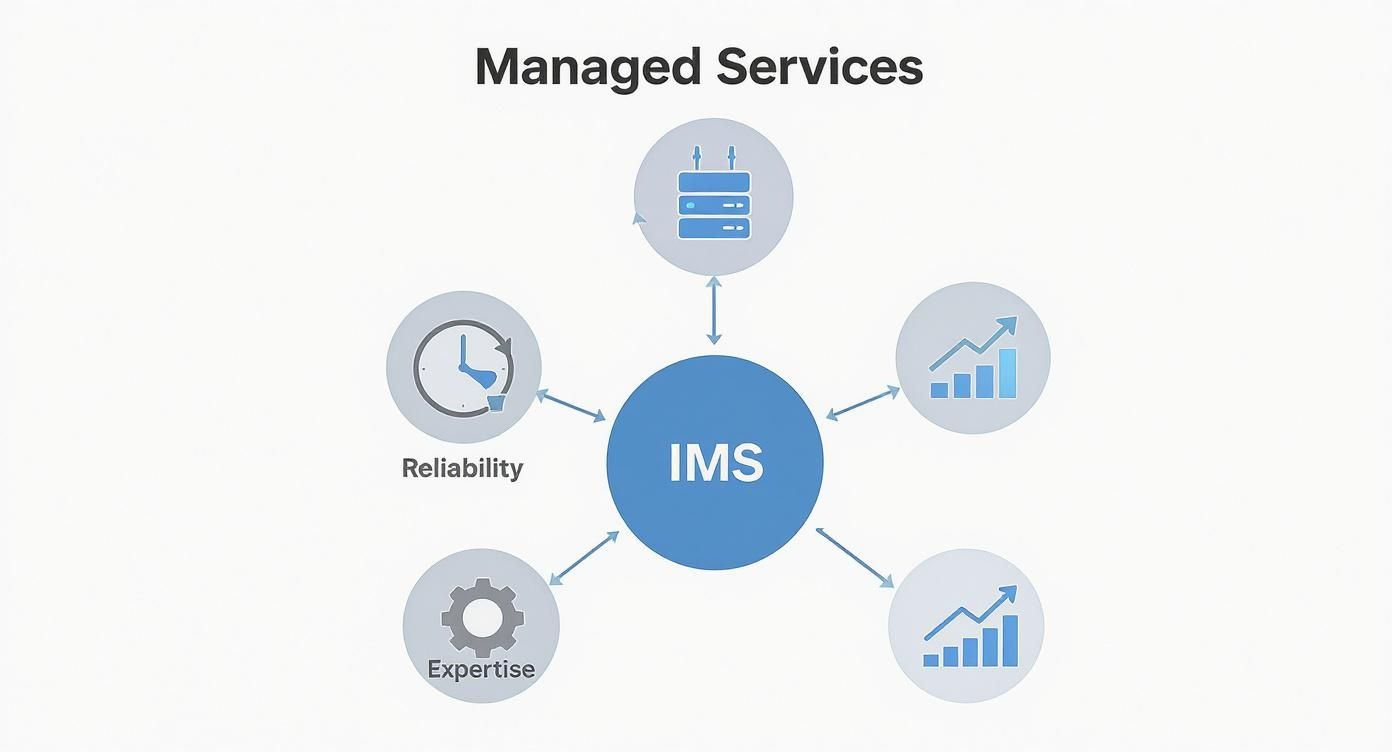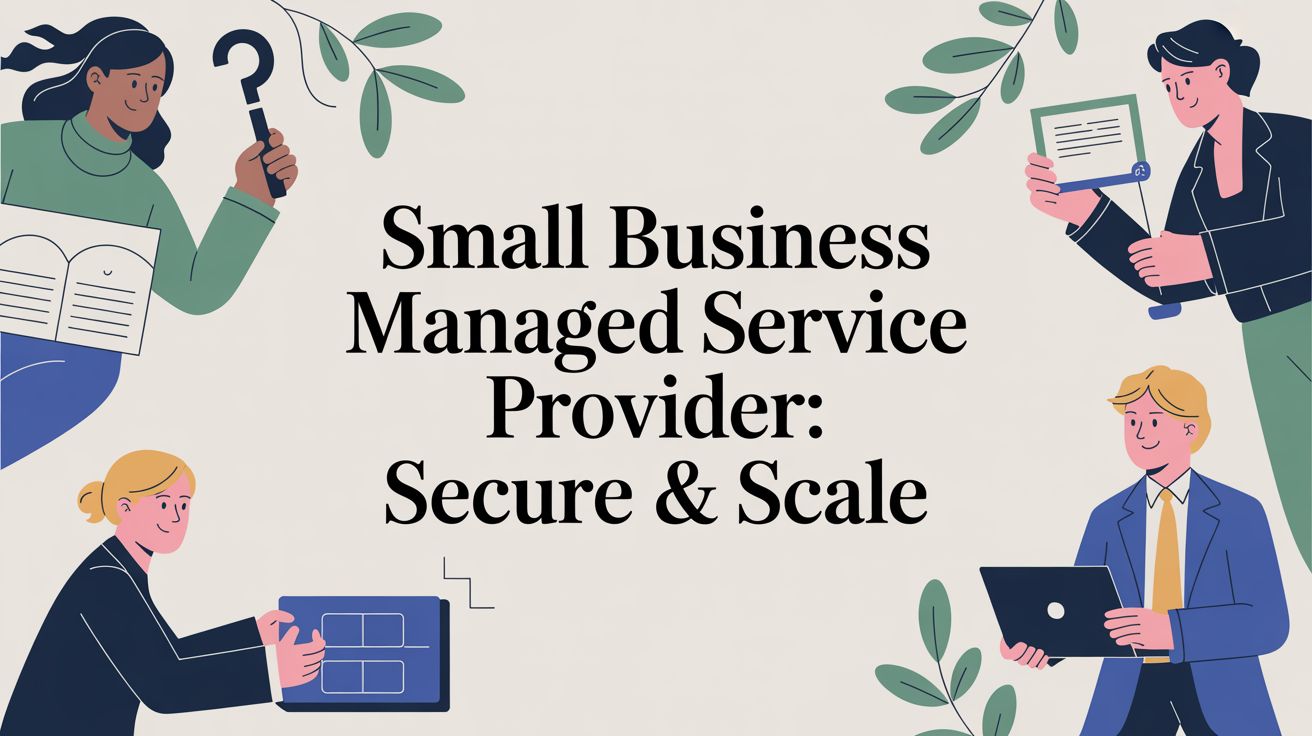
November 23, 2025
Choosing a Cyber Security Service Your Business Can TrustDiscover how a cyber security service protects your business. Learn to choose the right partner to safeguard your assets from digital threats in Canada.
Read Full Post%20(1).webp)
Usman Malik
Chief Executive Officer
November 24, 2025

When you hear the term infrastructure managed services, it might sound like another piece of complex IT jargon. But the concept is actually quite simple: it’s about handing over the management of your core IT infrastructure—your servers, networks, storage, and cloud environments—to a team of dedicated experts.
It’s a strategic shift away from the old break-fix model. Instead of waiting for something to go wrong and then scrambling to fix it, this proactive approach is all about preventing problems before they start.
Think of your IT infrastructure as the central nervous system of your business. For anything else to work, it has to function flawlessly, 24/7. But what happens when your internal team is so busy troubleshooting network glitches, applying security patches, or juggling server capacity that they have no time left for projects that actually move the business forward? Growth grinds to a halt.
This is precisely the problem that infrastructure managed services are built to solve. Rather than being a reactive cost centre you only call when something breaks, a managed services partnership provides constant, expert oversight. It’s like having a world-class property manager for your entire digital estate—they handle the routine maintenance, shore up security, and make sure everything is running at peak performance. This frees up your team to focus on what they do best: driving your business goals.
Many Canadian businesses still operate with a traditional, reactive IT mindset. An employee finds a problem, they submit a ticket, and a technician eventually gets around to diagnosing and fixing it. This model is inefficient and almost always leads to frustrating—and expensive—downtime.
A managed services model completely flips this script.
"For technology leaders who manage business-critical cloud workloads, the challenge is clear: How do you maintain operational excellence while freeing your team to focus on innovation and core business objectives? The answer lies not in building larger operations teams, but in partnering with experts."
This proactive approach means your managed services provider (MSP) uses advanced monitoring tools to spot potential issues long before they can impact your operations. In the real world, this looks like:
For medium-sized organizations, the benefits are significant. You gain access to a deep bench of specialists—experts in cybersecurity, cloud architecture, and network engineering—without the staggering cost of hiring them full-time.
It levels the playing field, allowing you to compete with larger enterprises that have enormous IT budgets.
We've put together a quick comparison to show the difference this shift in approach can make for your business.
This table highlights how outsourcing infrastructure management isn't just about cutting costs—it's about gaining a strategic partner dedicated to your success.
This transition turns your IT department from a group that fixes problems into a team that actively drives innovation. By offloading the day-to-day operational grind, you empower your internal staff to work on projects that directly boost revenue and fuel growth. To see how this fits into the bigger picture, you can learn more about the fundamentals of managed IT services in our detailed guide.
Ultimately, it’s about building a stable, secure, and scalable foundation that will support your business’s success for years to come.
To get a better sense of what infrastructure managed services bring to the table, it helps to look at what a provider actually manages. These components are the engine of your digital operations, and their health directly impacts your company's productivity, security, and potential for growth.
A great managed services partner does more than just fix things when they break. They take a holistic view of your entire IT system, ensuring every component is running at peak performance. This approach prevents small, isolated problems from snowballing into major shutdowns, giving your business the stable foundation it needs to succeed.
This diagram shows how a central managed services strategy directly fuels reliability, provides expert oversight, and drives strategic growth for your business.

As you can see, centralizing IT management helps a business achieve consistent uptime, tap into specialized expertise, and ensure its technology is aligned with its long-term goals.
Think of your network as the digital highway system for your business. It's the route every piece of data takes, from simple emails to critical customer transactions. Network management is all about keeping this highway clear, fast, and secure, preventing the digital traffic jams that grind your team to a halt.
A managed services provider will handle:
Without proactive management, a sluggish or unreliable network can quickly become a major drain on employee morale and productivity.
Your servers and storage systems are the heart of your IT infrastructure—they're where your most important applications and data live. Whether you have physical servers in an office or virtual machines in the cloud, they all need constant attention to run properly. This is where server and storage management is essential.
This service covers everything from initial setup and configuration to ongoing maintenance and eventual retirement of your server environment. It includes crucial tasks like applying OS updates, managing storage space, and fine-tuning server performance to keep your applications running smoothly. The end goal is simple: ensure your team has reliable access to the tools and data they need, whenever they need them.
The concept of a data centre is no longer just a room full of servers. Today, it’s a complex mix of on-premises hardware, private clouds, and public cloud services from providers like Microsoft Azure. Juggling this hybrid environment requires a specific skill set to keep everything integrated and cost-effective.
Data centre services look after the physical and virtual spaces where your infrastructure resides. This means managing power, cooling, and physical security for your on-premises equipment, while also setting up and optimizing resources in the cloud. As businesses continue to expand their digital operations, the evolving landscape of infrastructure is adapting to meet new demands.
A well-managed infrastructure allows your business to scale resources up or down on demand, paying only for what you use while maintaining high levels of performance and security across all environments.
In today's digital world, cybersecurity isn't just an add-on; it's a fundamental part of managing IT infrastructure. A good managed services provider acts as your dedicated security team, building a multi-layered defence to protect your business from an endless list of digital threats.
This comprehensive protection includes:
On top of all that, a knowledgeable partner will help you navigate the complex world of compliance, ensuring your infrastructure meets industry regulations like PIPEDA in Canada. To learn more about these foundational elements, check out our guide on the core components of IT infrastructure.
Engaging infrastructure managed services is much more than a simple IT upgrade; it’s a strategic business decision that pays off in clear, measurable ways. For Canadian business leaders, this translates directly to a healthier bottom line, tighter security, and a renewed focus on what drives growth. It's about turning IT from an unpredictable expense into a reliable, performance-boosting asset.
One of the first things you'll notice is the shift from volatile capital expenditures (CapEx) to predictable operational expenses (OpEx). Instead of being hit with sudden, budget-breaking costs for a server failure or a mandatory hardware refresh, you pay a consistent monthly fee. This financial stability makes forecasting easier and frees up capital for other strategic investments.

This model gives medium-sized businesses the kind of financial agility usually reserved for large enterprises, ensuring technology costs align perfectly with your operational budget.
In a world where cyber threats are constantly changing, maintaining enterprise-grade security is a significant challenge. An infrastructure managed services provider gives you access to a dedicated team of cybersecurity experts whose entire job is to stay ahead of those threats. It's a level of protection most medium-sized businesses could never afford to build in-house.
This partnership ensures your operations are protected by:
By partnering with a managed services provider, you gain a strategic ally dedicated to safeguarding your most valuable asset—your data. This proactive stance on security is no longer a luxury but a fundamental requirement for doing business in Canada.
Downtime is a silent killer of productivity and revenue. Every minute your systems are offline, your team can't work, and your customers can't be served. Proactive monitoring, a core principle of managed services, is designed to prevent these disruptions. By identifying and fixing potential issues before they escalate, your provider ensures maximum uptime.
This reliability keeps your team productive and focused. It eliminates the frustration and lost momentum caused by unexpected outages, leading to a more efficient and effective workforce.
Perhaps the most powerful benefit is what it does for your internal IT staff. When your team is no longer bogged down by routine maintenance, password resets, and troubleshooting, they are free to work on high-value projects that move the business forward.
Instead of fighting daily fires, they can concentrate on:
This shift transforms your IT department from a reactive support function into a proactive engine for innovation. To delve deeper, you can explore the many benefits of managed IT services in our comprehensive article. By entrusting your infrastructure to experts, you empower your best people to focus on what they do best—growing your business.
Choosing managed services is a big decision, but it’s not the last one you’ll make. Now you have to pick a service model, and this is where it gets crucial. Getting this right is key to making sure the partnership fits your goals, budget, and the way you operate.
Think of it like choosing a mobile phone plan. You don’t just grab the cheapest one; you find the plan that gives you the right amount of data and features for how you use your phone. The right managed services model works the same way—it gives you a framework that supports your growth, offering flexibility where you need it and stability where it counts. Making the right choice now will save you headaches later and ensure you’re getting real value.
One of the most popular choices, especially for businesses that need budget predictability, is the all-inclusive model. This approach bundles everything—proactive monitoring, maintenance, security, and support—into a single, predictable monthly fee, usually calculated on a per-user or per-device basis.
For finance leaders, this model is a dream. It turns unpredictable IT costs into a fixed operational expense. No more surprise repair bills or emergency project fees throwing your budget into chaos. This setup is perfect for organizations that need full-scale support but don’t want the hassle of tracking hourly rates or service tickets.
The real beauty of the all-inclusive model is its simplicity. You know exactly what you're paying each month for a complete suite of services, which makes budgeting and financial forecasting straightforward and surprise-free.
This model is a great fit for businesses with stable IT needs that are looking for a "set it and forget it" solution where the provider handles everything.
While the all-inclusive model is simple, some businesses need more flexibility. That’s where tiered and custom models shine. A tiered approach gives you a few different packages—think Bronze, Silver, and Gold—each offering a broader scope of services as you move up. A basic tier might cover essential monitoring and patching, while a premium tier could add advanced cybersecurity and strategic consulting.
This lets you pay only for what you need right now, with a clear path to upgrade as your business expands. A small business, for instance, could start with a basic package and move to a higher tier once they hire more staff or roll out more complex software.
A fully custom model takes this a step further by letting you build a service package from scratch. This à la carte approach is ideal for organizations with unique requirements, like a mix of on-premises and cloud hardware. If you're weighing your infrastructure options, it’s important to understand the differences; we break it all down in our guide on on-premises vs. cloud computing.
Picking the best delivery model means taking an honest look at your own operations. Before you talk to a provider, ask yourself these questions to get a clearer picture of what you need:
Answering these questions first will put you in a great position to choose a managed services model that doesn’t just fit your budget but truly helps your business grow.
A one-size-fits-all approach to IT infrastructure just doesn't work. Different industries face completely different operational hurdles and regulatory demands. Real infrastructure management isn't just about keeping the lights on; it’s about having a deep, practical understanding of your specific sector. The goal is to ensure your technology doesn't just work, but actively helps you stay compliant and achieve your business targets.
When your IT partner speaks the language of your industry, everything changes. They can build and manage an IT environment that reflects the day-to-day realities you face. Your infrastructure stops being a potential headache and starts becoming a genuine strategic advantage.
For Canadian healthcare organizations—from local clinics to specialized care centres—IT infrastructure is the literal backbone of patient care. The biggest challenge is a constant balancing act: you need systems that are always online while also protecting patient data under strict provincial laws like Ontario's Personal Health Information Protection Act (PHIPA).
An experienced managed services provider understands this. They focus on:
The financial services world operates under a microscope where security and data integrity are non-negotiable. For investment firms, insurance brokers, and accounting practices, the infrastructure has to be a fortress against cyber threats, all while satisfying the tough demands of bodies like the Investment Industry Regulatory Organization of Canada (IIROC).
A specialized partner delivers what's needed:
In manufacturing, it all comes down to operational efficiency. With the rise of the Industrial Internet of Things (IIoT) and connected technology on the factory floor, a stable, high-performance network is more critical than ever. A single network hiccup can bring a production line to a grinding halt.
A resilient and secure network is the foundation of the modern smart factory. It ensures that data from sensors, machinery, and production systems flows uninterrupted, enabling real-time decision-making and operational excellence.
This reliance on digital infrastructure means manufacturers need a solution that can support everything from supply chain systems to automated robotics, ensuring the entire production lifecycle runs like a well-oiled machine.
Choosing a provider for your infrastructure managed services is one of the most critical business decisions you’ll make. This isn’t just about finding a vendor to fix what’s broken; it’s about selecting a partner who is invested in your long-term success. The right partner becomes an extension of your team, providing the strategic guidance that helps you grow.
The evaluation process has to go far beyond a simple price comparison. You need to look for a blend of technical skill, industry knowledge, and a proactive mindset. A great partner doesn’t just react to problems—they anticipate them, working to keep your operations smooth, secure, and efficient.

The Service Level Agreement (SLA) is the contract that defines your entire relationship. While it can be technical, this document outlines the provider’s commitments on critical items like system uptime, support response times, and maintenance schedules. Reviewing this carefully is non-negotiable.
A strong SLA should be clear, measurable, and perfectly aligned with your business needs. Look for specifics. For example, instead of a vague promise of "high uptime," a solid SLA will guarantee 99.9% availability for your critical systems. This is your assurance that the provider is accountable for delivering the performance your business requires.
Your potential partner must have the technical expertise to manage your specific environment, whether it's on-premises, in the cloud, or a hybrid of both. Don’t be afraid to ask for proof. Look for certifications from major technology vendors and ask for case studies or references from businesses similar to yours.
Equally important is their grasp of the Canadian business landscape. A provider with experience in your industry will already be familiar with the regulatory requirements you face, such as PIPEDA. This specialized knowledge is invaluable for ensuring your infrastructure is not only efficient but also fully compliant. To better understand what this entails, see our guide on choosing the right IT outsourcing company for your needs.
Technical skills are essential, but the partnership will fall flat without strong communication and a good cultural fit. How does the provider communicate? Are they proactive with updates and strategic recommendations, or do you only hear from them when something is wrong? Remember, you're looking for a partner, not just a helpdesk.
The ideal partner is proactive, transparent, and genuinely committed to understanding your business goals. They should feel like a part of your team, working alongside you to turn your IT infrastructure into a strategic asset.
During the evaluation process, pay close attention to how they interact with your team. Do they listen to your concerns? Are they patient when explaining complex topics? This human element is often the deciding factor between a frustrating vendor relationship and a successful, long-term partnership.
Stepping into the world of managed IT services can bring up a few questions. That's completely normal. To help clear things up, here are some straight answers to the most common queries we hear from Canadian business leaders.
Not at all. A strong managed services partnership actually enhances your control by giving you better visibility, detailed reporting, and expert strategic guidance you might be missing now. You’re still the one setting the business goals; your provider is the expert crew handling the technical execution.
Think of it this way: you’re still in the driver's seat, but now you have a team of professional co-pilots navigating the complex technical terrain for you. You get to focus on the destination, knowing the journey is secure and efficient.
This is a common myth. The reality is that managed services are often most valuable for small and medium-sized businesses (SMBs). Most SMBs can't justify the cost of hiring a full-time, in-house team stacked with specialists in cybersecurity, cloud architecture, and network engineering.
An MSP gives you access to that same enterprise-level expertise at a predictable, fractional cost. It allows you to compete with larger businesses, securing your operations and scaling your technology without the massive upfront investment in salaries and benefits.
A smooth transition is everything, and it’s built on a structured, transparent process. It's a carefully planned handover designed to cause zero disruption to your business.
A proven migration process typically includes these key steps:
The real goal of a professional migration is to make the change feel effortless for your team. A good provider manages the entire process with constant, clear communication, ensuring your operations keep running without a hitch.
This methodical approach ensures that your new partnership starts on a stable, secure, and optimized IT foundation right from the get-go.
Ready to turn your IT from a cost centre into a strategic asset? At CloudOrbis Inc., we provide proactive infrastructure managed services that give Canadian businesses the security, reliability, and expert support needed to thrive. Let's build a technology foundation that truly powers your growth. Learn more about how CloudOrbis can help.

November 23, 2025
Choosing a Cyber Security Service Your Business Can TrustDiscover how a cyber security service protects your business. Learn to choose the right partner to safeguard your assets from digital threats in Canada.
Read Full Post
November 22, 2025
Small Business Managed Service Provider: A Guide to Security & GrowthLearn how a small business managed service provider can secure, streamline, and scale operations. Find essential services and how to choose a partner.
Read Full Post
November 21, 2025
Managed Services for Small Business ExplainedDiscover how managed services for small business can unlock growth, improve security, and cut costs. A clear guide for Canadian SMBs.
Read Full Post